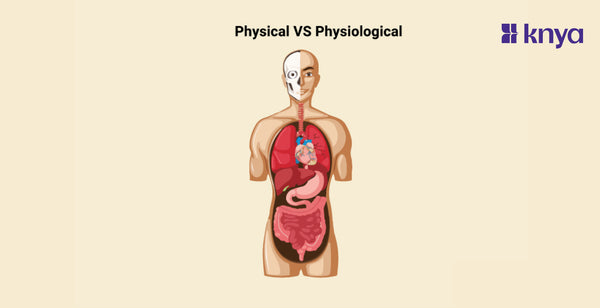Difference Between Physical and Physiological: In the exploration of the human body and its functions, the terms "physical" and "physiological" encapsulate distinct dimensions, each offering unique insights. While both are integral to the understanding of health and well-being, they pertain to different aspects of the body's mechanisms. Let's delve into the Difference between physical and physiological, unraveling the key points that set them apart:
- Physical:
- Encompasses the tangible and observable attributes of the body.
- Relates to the structural aspects, appearance, and biomechanics.
- Involves the examination of external characteristics, such as size, shape, and movements.
- Physiological:
- Pertains to the internal, functional processes and mechanisms of living organisms.
- Focuses on the study of biochemical, biomechanical, and systemic functions.
- Explores how the body's systems work together to maintain balance and facilitate life processes.
Difference Between Physical and Physiological
Here's a table summarizing the main differences between physical and physiological:
|
Feature |
Physical |
Physiological |
|
Definition |
Pertaining to the body's structure or external attributes. |
Relating to the body's internal functions, processes, and mechanisms. |
|
Nature |
Involves tangible characteristics or properties of the body. |
Encompasses the body's dynamic and functional aspects. |
|
Examples |
Height, weight, color, and shape of organs or body parts. |
Heart rate, blood pressure, hormone levels, and cellular processes. |
|
Measurement |
Typically measured using instruments or physical assessments. |
Often requires medical instruments and laboratory tests for accurate measurement. |
|
Observable |
Observable through external examination or imaging techniques. |
Often requires specialized equipment to observe internal processes. |
|
Changes Over Time |
May change with growth, development, or external influences. |
Dynamic and subject to constant adjustments for maintaining homeostasis. |
|
Influence on Health |
Can influence health indirectly, such as through body composition. |
Directly linked to overall health and homeostasis, reflecting the body's functioning. |
|
Response to Exercise |
May change with exercise, affecting muscle mass or body composition. |
Involves complex physiological responses, including cardiovascular adaptations and metabolic changes. |
|
Diagnostic Tools |
Relies on physical examinations, imaging, and basic measurements. |
Requires medical diagnostics, such as blood tests, ECGs, and other specialized assessments. |
|
Treatment Focus |
May involve physical therapy or interventions targeting external attributes. |
Focuses on interventions to restore or optimize internal physiological processes. |
Check out the Best Scrubs Collection Here!
What is Physical Condition
Physical condition refers to the overall state or health of an individual's body, encompassing various aspects of physical well-being and fitness. It includes the evaluation of factors such as strength, flexibility, endurance, body composition, and general health. The physical condition of an individual is influenced by a combination of genetic factors, lifestyle choices, exercise habits, and overall health practices.
Components of Physical Condition:
- Strength: The ability of muscles to generate force during activities.
- Endurance: The capacity of the body to sustain prolonged physical activity.
- Flexibility: The range of motion around joints, indicating the ability to move freely.
- Cardiovascular Fitness: The efficiency of the cardiovascular system in delivering oxygen and nutrients to the body during exercise.
- Body Composition: The proportion of fat, muscle, and other tissues in the body.
Maintaining a good physical condition is essential for overall health and quality of life. Regular physical activity, a balanced diet, proper hydration, and adequate rest contribute to optimizing physical condition. Additionally, regular health check-ups and assessments can help individuals monitor and manage their physical well-being.
What is the Physiological Condition
Physiological condition refers to the state of functioning and equilibrium within the body's internal systems and processes. It involves the dynamic interplay of various physiological parameters, such as hormonal balance, organ function, cellular activities, and overall homeostasis. The physiological condition of an individual is closely linked to the proper functioning of bodily systems, ensuring that essential processes maintain balance and support health.
Components of Physiological Condition:
- Hormonal Balance: The regulation and balance of hormones that control various bodily functions.
- Organ Function: The optimal functioning of organs and organ systems, including the heart, lungs, liver, kidneys, and others.
- Metabolic Processes: The efficiency of metabolic activities, including energy production, nutrient utilization, and waste elimination.
- Neurological Function: The proper functioning of the nervous system, including brain activity and the transmission of nerve impulses.
- Immune System Response: The ability of the immune system to respond effectively to pathogens and maintain overall immunity.
- Blood Circulation: The circulation of blood to deliver oxygen, nutrients, and hormones throughout the body.
Maintaining a healthy physiological condition is essential for the body to adapt and respond to various internal and external challenges. Factors such as nutrition, regular exercise, adequate rest, and stress management play crucial roles in supporting optimal physiological function. Medical assessments, including blood tests and diagnostic tools, are often used to evaluate and monitor physiological conditions.
Similarity Between Physical and Physiological
While physical and physiological conditions represent distinct aspects of health, their close relationship emphasizes the importance of addressing both for comprehensive health management.
- Health Impact: Both physical and physiological aspects significantly contribute to an individual's overall health and well-being.
- Lifestyle Influence: Lifestyle choices, including diet, exercise, and habits, can influence both physical and physiological conditions.
- Dynamic Nature: Both physical and physiological conditions are dynamic and can change over time based on various factors, including aging, environmental influences, and lifestyle changes.
- Interconnectedness: Physical and physiological conditions are interconnected, with changes in one often affecting the other. For example, regular exercise not only impacts physical strength but also influences physiological factors like cardiovascular health.
- Diagnostic Assessments: Medical professionals use diagnostic assessments and tests to evaluate both physical and physiological conditions, ensuring a comprehensive understanding of an individual's health.
- Holistic Approach: Both conditions benefit from a holistic approach to health, considering various factors such as nutrition, exercise, sleep, and stress management.
- Quality of Life: The quality of life is closely tied to both physical and physiological well-being, with optimal conditions contributing to a higher quality of life.
- Individual Variability: There is considerable variability among individuals in both physical and physiological conditions, influenced by genetics, lifestyle, and environmental factors.















